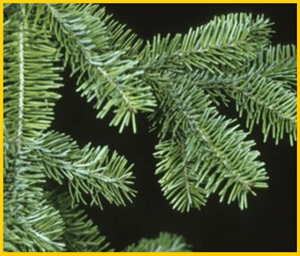Yellow Trail Guide
The Geology (Marker 1)

The staging area (where the trails begins and ends) is on a large, flat area of limestone rock. It may be hard to believe, but this limestone plateau was under a massive ocean hundreds of millions of years ago during the Ordovician Period. Over the years, the sediment on the ocean floor was buried and compressed to form the flat, grey rock you see beneath your feet.
The Fossils
Look closely at this limestone plateau and you should be able to see remnants of this area’s ancient inhabitants. There are small shell shapes in the rock and long, cone-like and tube-like fossils. As they died, sea creatures sank to the bottom of the ocean and were covered with silt and sand. Over a great deal of time, these remains absorbed the minerals in the mud and silt. There are no biological remains left, what you see here is the imprint of an ancient creature engraved in stone. Reach out and touch something that was alive from before the time of the dinosaurs!
Cephalopod Fossils
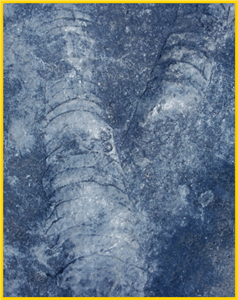 One of the more recognizable fossils you may see are the remains of an undersea invertebrate called a Cephalopod. These creatures flourished more than 400 million years ago. They had an elongated shell and no bone structure. These creatures are related to modern-day squids, octopi and nautiluses. The ancient variety moved by using a jet stream of water pushed through their bodies.
One of the more recognizable fossils you may see are the remains of an undersea invertebrate called a Cephalopod. These creatures flourished more than 400 million years ago. They had an elongated shell and no bone structure. These creatures are related to modern-day squids, octopi and nautiluses. The ancient variety moved by using a jet stream of water pushed through their bodies.
Fungia Fossils
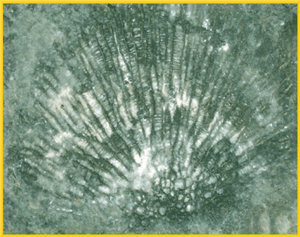 The shapes you see that resemble shells are not in fact fossilized “clams.” These fan shapes are from ancient coral that lived around the same time period as the cephalopods (about 425 million years ago). They have not really changed that much over the eons. Modern day corals are comparable in shape and size to their ancient relatives.
The shapes you see that resemble shells are not in fact fossilized “clams.” These fan shapes are from ancient coral that lived around the same time period as the cephalopods (about 425 million years ago). They have not really changed that much over the eons. Modern day corals are comparable in shape and size to their ancient relatives.
Limestone Rock
Limestone is a sedimentary rock formed from the sea beds of evaporated oceans. This means that it is made up of fine particles that settled on the seabed. The main component of limestone is calcium carbonate. This chemical came from the remains of the creatures you see fossilized at your feet and also from the limy ooze that was created in the ancient ocean. It is relatively soft and can be dissolved by mild acids such as vinegar.
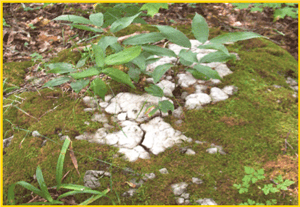 This limestone is very important to the local habitat because of its composition.
This limestone is very important to the local habitat because of its composition.
The basic nature of the limestone pH gives the soil a different acidity level, allowing many plants and trees suited to soils of low acidity to flourish here. Limestone is a semi-permeable mineral, meaning that water can slowly pass through it, becoming enriched with minerals that plants and trees need to grow. As the cracks and crevices in the limestone rocks collect organic material, these spots become ideal areas for plants to grow. Broken limestone rocks buried under the soil also provide “anchors” for trees when they reach maturity.
The Forest (Marker 2)
 The forests of Ontario are home to many species of plant, tree, animal, and insect. These plants and creatures live together in a complex ecosystem. Each part depends on the next for its continued existence. The beginning of the Yellow Trail enters into a deciduous hardwood forest ecosystem.
The forests of Ontario are home to many species of plant, tree, animal, and insect. These plants and creatures live together in a complex ecosystem. Each part depends on the next for its continued existence. The beginning of the Yellow Trail enters into a deciduous hardwood forest ecosystem.
The Hardwood Forest
The trees in the hardwood forest are deciduous. This means that the trees lose their leaves during the fall and winter months. The term “hardwood” refers to the density of the tree’s wood. There are a number of different types of trees in hardwood forests, some you may already be familiar with and some may be new to you. Sugar Maple, Oak, and Birch trees are just a few of the tree types commonly found in these forests. Hardwood forests typically allow light to come in through the canopy (the overhead roof of leaves and branches), allowing ground plants to germinate and grow. This is an important feature of this type of the forest.
Sugar Maple
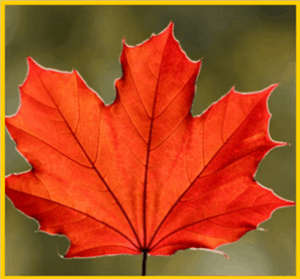 The Sugar Maple is one of Canada’s most recognized tree species. This tree is typically large and sturdy, and can live up to 300 years or more. These types of trees are a common species in Southern Ontario and is the source of maple syrup.
The Sugar Maple is one of Canada’s most recognized tree species. This tree is typically large and sturdy, and can live up to 300 years or more. These types of trees are a common species in Southern Ontario and is the source of maple syrup.
Saplings (baby trees) are highly tolerant of shade and as a result can live longer than other tree types in the shade of the canopy. The leaves are 5-lobed and easily recognizable from its place on the Canadian flag. In the autumn the leaves change to a brilliant yellow or orange-yellow colour as chlorophyll dissipates (this process will be discussed later in detail). The Maple Tree is home to birds and insects, and provides cover for deer, moose, squirrels, chipmunks, porcupine, and raccoons. Many of these creatures create homes in the upper branches of the tree. The seeds are food for field mice, other small mammals, and insects. These small creatures in turn feed larger predators such as owls, foxes, and snakes. The Sugar Maple is an essential part of the forest and is a key player in the forest ecosystem.
White Oak
 The White Oak is a large tree and has distinct oak family leaves that have many leaf tips. This type of tree produces acorns that take several years to mature after they germinate. Oak trees produce orange or purple coloured leaves in the fall season, and may even keep some of their leaves into the winter. Leaf shapes can vary greatly, even on the same tree. Like the Maple, the seeds (acorns) are a source of food for many small mammals. Every 4-5 years the Oak trees mast, producing thousands of extra acorns, many more than the forest animals can consume. This abundance of acorns ensures enough seeds will be left to produce seedlings. Red Oak trees are shade-resistant when young but will fail to reach their full height if shaded from direct sunlight.
The White Oak is a large tree and has distinct oak family leaves that have many leaf tips. This type of tree produces acorns that take several years to mature after they germinate. Oak trees produce orange or purple coloured leaves in the fall season, and may even keep some of their leaves into the winter. Leaf shapes can vary greatly, even on the same tree. Like the Maple, the seeds (acorns) are a source of food for many small mammals. Every 4-5 years the Oak trees mast, producing thousands of extra acorns, many more than the forest animals can consume. This abundance of acorns ensures enough seeds will be left to produce seedlings. Red Oak trees are shade-resistant when young but will fail to reach their full height if shaded from direct sunlight.
White Birch
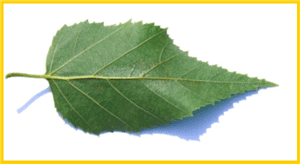 The White Birch is easily identified by the grayish to white bark of the mature tree. The wood is soft although it typically grows in hardwood forests where soil acidity tends to be lower. The bark is highly flammable and has been used as tinder and building material by North American Indigenous peoples for centuries. The tree is a favorite of the Yellow-bellied Sapsucker for its soft bark that houses insects. The Sap sucker will drill holes in the tree that become wells from which sap flows. These sap-wells are a key part of the ecosystem. Because butterflies and hummingbirds returning to the area after winter will arrive before flowers have started to bloom, these ready-made feeding spots are a critical source of food. The White Birch is also a primary food source for moose, porcupine, and beaver. The seeds are food for many different types of songbirds.
The White Birch is easily identified by the grayish to white bark of the mature tree. The wood is soft although it typically grows in hardwood forests where soil acidity tends to be lower. The bark is highly flammable and has been used as tinder and building material by North American Indigenous peoples for centuries. The tree is a favorite of the Yellow-bellied Sapsucker for its soft bark that houses insects. The Sap sucker will drill holes in the tree that become wells from which sap flows. These sap-wells are a key part of the ecosystem. Because butterflies and hummingbirds returning to the area after winter will arrive before flowers have started to bloom, these ready-made feeding spots are a critical source of food. The White Birch is also a primary food source for moose, porcupine, and beaver. The seeds are food for many different types of songbirds.
What happens in winter?
The hardwood forest is a special place in Southern Ontario during the fall and winter months (September-March). The trees basically shut down. They lose their leaves in a brilliant display of colour. The temperature changes in September tell the trees that they must prepare for the long, cold winter months ahead. They do this by literally sucking the chemicals out of the leaves and storing them inside the tree for use next spring. The chemical that makes the leaves appear green (called chlorophyll) stops being produced, revealing vibrant colours produced by other chemicals in the leaves. This does not hurt the trees and it plays a very important role not only for the trees’ health but also for the strength of other parts of the ecosystem. The fallen leaves become food for other living organisms as they decompose on the forest floor, and act as an insulator on the ground preventing severe frost damage to ground plants and small trees. Mice, insects, salamanders, and many other woodland creatures use this blanket of leaves as protection from the extreme temperatures as they sleep away the winter. The process of losing leaves in the fall plays a critical role in the forest ecosystem.Another creature among the forest floor material and under rotting logs or rocks is the Blue Spotted Salamander. These little creatures live in the same sorts of areas as the Red Back Salamander and belong to the same family. They differ in size and reproduction techniques from their relative the Red Back. The Blue Spotted Salamander can grow up to 5.5 inches and reproduces in forest ponds or small marshes. The males perform a mating dance—a wiggling motion which attracts females—in these wet areas.
When a suitable pairing has been made, they will leave the other dancing males and the male will deposit “spermatophores” on pieces of underwater debris which the female uses to fertilize her eggs before laying 1-3 egg clusters on underwater vegetation. After about 6 weeks the eggs will hatch and give birth to small larvae that will begin developing into terrestrial salamanders.
Eastern Garter Snake
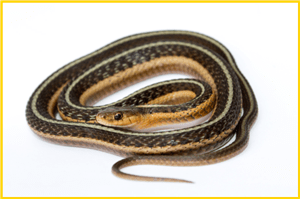 The Eastern Garter Snake is a common sight across Ontario. These snakes are black with a yellow stripe on the back. Although not venomous they will bite if they feel threatened. They eat toads, frogs, and other small woodland creatures. The reproduction of these reptiles is unique. When the time comes the males will gather in massive numbers and make a “snake spaghetti”, a seething mass of writhing males. When the females select a male, the pair will mate and the female will lay her eggs. Garter snakes hibernate in underground in areas known as hibernaculums during the winter months.
The Eastern Garter Snake is a common sight across Ontario. These snakes are black with a yellow stripe on the back. Although not venomous they will bite if they feel threatened. They eat toads, frogs, and other small woodland creatures. The reproduction of these reptiles is unique. When the time comes the males will gather in massive numbers and make a “snake spaghetti”, a seething mass of writhing males. When the females select a male, the pair will mate and the female will lay her eggs. Garter snakes hibernate in underground in areas known as hibernaculums during the winter months.
Ground Debris (Marker 4)
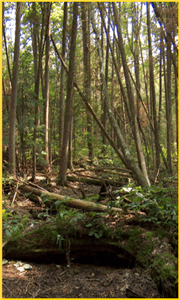 Logs, sticks, leaves, rocks, and other ground debris creates valuable habitats for salamanders, snails, spiders, and many other types of animals and insects. It may look like forest “garbage” but it plays an absolutely key role in sustaining the forest and all of its life. The rotting organic material supplies the trees, grasses, and plants with much needed nutrients and is an essential part of the forest ecosystem. The debris holds moisture longer than the ground and provides an ideal site for life to begin. Rotting logs often act as nurseries for plants. As seeds fall to the ground they sometimes get caught up in the logs and stumps where they can germinate with ease. From the death of trees and plants comes a rebirth of life.
Logs, sticks, leaves, rocks, and other ground debris creates valuable habitats for salamanders, snails, spiders, and many other types of animals and insects. It may look like forest “garbage” but it plays an absolutely key role in sustaining the forest and all of its life. The rotting organic material supplies the trees, grasses, and plants with much needed nutrients and is an essential part of the forest ecosystem. The debris holds moisture longer than the ground and provides an ideal site for life to begin. Rotting logs often act as nurseries for plants. As seeds fall to the ground they sometimes get caught up in the logs and stumps where they can germinate with ease. From the death of trees and plants comes a rebirth of life.
Creatures common in ground debris
The following are just a few of the creatures that you can find under and in the ground debris. We invite you to look, but please don’t touch. You will often be able to locate one or more of these creatures, but they are most sensitive and it is important not to handle or touch them. We can appreciate their intricate beauty from a short distance.
Eastern Chipmunk
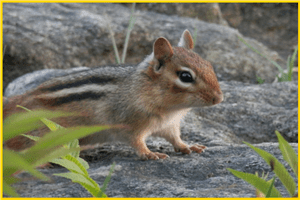 Chipmunks are humorous little characters. A white belly and striped back identifies these rodents. They are often seen around people’s homes eating and gathering food for the winter. They reproduce in early spring and have litters from 2 to 5 young. Chipmunks are very vocal and make a “chip-chip” noise as they talk. They have a wide range of food preferences, eating almost anything that can fit in their mouth.
Chipmunks are humorous little characters. A white belly and striped back identifies these rodents. They are often seen around people’s homes eating and gathering food for the winter. They reproduce in early spring and have litters from 2 to 5 young. Chipmunks are very vocal and make a “chip-chip” noise as they talk. They have a wide range of food preferences, eating almost anything that can fit in their mouth.
Red Backed Salamander
 The Red Backed Salamander is an amphibian that lives in abundance on the Yellow Trail forest floor. They live under logs and ground debris in moist dark areas, laying its eggs in rotten logs. The larvae stage of reproduction occurs within the egg with very small salamanders emerging when they hatch. The eggs are guarded by a vigilant parent during the summer months. They have a territory of about 1 square metre. It takes two years for these small salamanders to reach maturity, and they can live up to a whopping 30 years!
The Red Backed Salamander is an amphibian that lives in abundance on the Yellow Trail forest floor. They live under logs and ground debris in moist dark areas, laying its eggs in rotten logs. The larvae stage of reproduction occurs within the egg with very small salamanders emerging when they hatch. The eggs are guarded by a vigilant parent during the summer months. They have a territory of about 1 square metre. It takes two years for these small salamanders to reach maturity, and they can live up to a whopping 30 years!
Blue Spotted Salamander
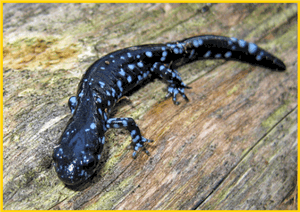
Holes in Trees (Marker 4)
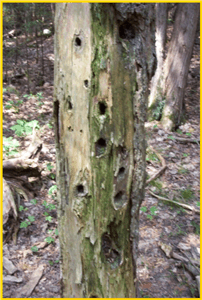 Holes in trees are very important and create habitats for many creatures to live in and feed from. Excavating birds such as the Hairy and Downy Woodpeckers make these holes initially while looking for insect larvae.
Holes in trees are very important and create habitats for many creatures to live in and feed from. Excavating birds such as the Hairy and Downy Woodpeckers make these holes initially while looking for insect larvae.
The Yellow-Bellied Sapsucker, as the name suggests, drills its holes to access sap from the trunks of trees. However, these holes continue to produce sap after the Sapsuckers have fed and departed. These “sap wells” remain for other animals, insects, and birds that would not otherwise be able to get at the sap in the tree trunks or branches. Hummingbirds love to consume the sweet fluids and it is important for them because they arrive in the area before the flowers have started to bloom. Hummingbirds would have a difficult time feeding in the early spring if the Sapsuckers had not prepared their meals for them. Ants and butterflies also enjoy consuming the fluids from these trees. The holes are very distinct often following a pattern. Other birds like the Woodpecker also create homes and feeding sites for other animals in the ecosystem. The interrelationships among the forest’s plants and animals are complex; each creature requires the next to continue its existence.
Grasses, Sedges and Rush (Marker 5)
 Identification of grasses is difficult because of the number of varieties that occur in this habitat. It is helpful to know that most long greens on the ground fall under one of several distinctions. Sedges, grasses and rushes are the three families to which almost all elongated greens belong. The difference between these families is in their stalks or stems. Grasses are hollow, rushes are round, and sedges have triangular stalks. Light that filters down through the hardwood canopy allowing many types of grass or sedge to grow. The Yellow Trail is an ideal spot for this to occur as the canopy allows sufficient light to get down to the forest floor and promote elongated greens growth.
Identification of grasses is difficult because of the number of varieties that occur in this habitat. It is helpful to know that most long greens on the ground fall under one of several distinctions. Sedges, grasses and rushes are the three families to which almost all elongated greens belong. The difference between these families is in their stalks or stems. Grasses are hollow, rushes are round, and sedges have triangular stalks. Light that filters down through the hardwood canopy allowing many types of grass or sedge to grow. The Yellow Trail is an ideal spot for this to occur as the canopy allows sufficient light to get down to the forest floor and promote elongated greens growth.
ACTIVITY: Sedges Have Edges!
Pick a blade of grass from the forest floor. Roll it between your thumb and index finger. If the stalk is triangular, you are holding a sedge species. If it is rounded, and the stalk is hollow then you have a grass species. Otherwise, it is a rush species.
Frog Orchestra (Marker 6)
 Check out our wetland. Created by the Shell Foundation, this constructed wetland is home to many frog species. If it is spring time, cup your hands behind your ears and listen for various frog sounds. You might hear the following…
Check out our wetland. Created by the Shell Foundation, this constructed wetland is home to many frog species. If it is spring time, cup your hands behind your ears and listen for various frog sounds. You might hear the following…
| SPECIES | SOUND | SEASON |
|---|---|---|
| SPRING PEEPER | High peep peep sound | Early Spring |
| AMERICAN BULLFROG | Deep, resonant rr-uum or jug-o-rum | Late Spring – Early Summer |
| WOOD FROG | Sounds like a quaking duck | Early Spring |
| GREEN FROG | gulp, gulp deep from the throat | Late Spring – Early Summer |
| LEOPARD FROG | A throaty ahhhhhhhhhh…. | Early Spring |
| CHORUS FROG | Short bursts of trills made with your lips or tongue | Mid- to Late Spring |
| AMERICAN TOAD | A sustained trill from lips or throat | Early to Late Spring |
| WESTERN TOAD | Soft, quickly repeated peep-peep | Late Winter – Early Spring |
ACTIVITY: Make a Balsam Fir Motor Boat
Also known as the blister tree, balsam fir is an evergreen with relatively smooth bark. Scattered long the bark at regular intervals are elongated “blisters,” tiny pockets full of sticky balsam fir sap. The needles of the Balsam Fir are shiny green and flat (you can’t roll a single needle in your fingers). From underneath, the needles are bluish-green in colour.
Take a small, sharp twig about 5 cm long and about as thick as a pencil led. Burst one blister with your twig and make sure there is a nice globule of sap attached to the twig. Carefully bring the twig and sap to a nearby pond (or quiet water source). Place the twig in the water.
Watch in amazement as the twig takes off like a motorboat, making twists and turns as it zooms along the surface of the water. The balsam sap contains an oil, which is considered hydrophobic (water hating). As the sap makes contact with the water, it repels water molecules and as a consequence drives the twig forward.
Balsam Fir sap was traditionally used as an antiseptic. It would be spread over wounds and infected areas. The sap, used sparingly can be harvested as a survival food. By chewing and not swallowing, the sap also makes a long lasting gum that eases hunger.
The Clearing (Marker 7)
The structure here was built by the Cub Scouts in the 1950s. Many of the flower species you can see in this area are really invasive species brought to this area by European settlers. Examples include Ox-eye Daisy and Orange and Yellow Hawkweed.
 The Ox-eye Daisy grows 30-100 cm tall and has small slender leaves that grow sporadically the length of the stem. These flowers are easily identified by the vibrant yellow disc that makes up the centre of the flower and the bright white petals of the flower itself. Called a “Daisy” because the yellow centre of the flower resembles the sun or “day’s eye,” this flower provides habitats and food for insects such as bees and butterflies. It is also a valuable source of food for hummingbirds and other birds during the summer months.
The Ox-eye Daisy grows 30-100 cm tall and has small slender leaves that grow sporadically the length of the stem. These flowers are easily identified by the vibrant yellow disc that makes up the centre of the flower and the bright white petals of the flower itself. Called a “Daisy” because the yellow centre of the flower resembles the sun or “day’s eye,” this flower provides habitats and food for insects such as bees and butterflies. It is also a valuable source of food for hummingbirds and other birds during the summer months.
 Orange and Yellow Hawkweed are both non-native species to southeastern Ontario. Like the Ox-eye Daisy, these flowers were introduced from Europe. They are easily recognized because of their vibrant colours. They can grow almost anywhere in the forest where sunlight can reach. These flowers play an important role in providing food for many species of butterfly and other insects. Hawkweeds are pollinated by several types of moths, including the lime-speck pug, the Hebrew character and the dot moth. The fruit and seeds of these perennials are an important source of food for animals ranging from the large yellow underwing moth to the common cottontail rabbit.
Orange and Yellow Hawkweed are both non-native species to southeastern Ontario. Like the Ox-eye Daisy, these flowers were introduced from Europe. They are easily recognized because of their vibrant colours. They can grow almost anywhere in the forest where sunlight can reach. These flowers play an important role in providing food for many species of butterfly and other insects. Hawkweeds are pollinated by several types of moths, including the lime-speck pug, the Hebrew character and the dot moth. The fruit and seeds of these perennials are an important source of food for animals ranging from the large yellow underwing moth to the common cottontail rabbit.
Softwood Forest (Marker 8)
The Yellow Trail contains two kinds of forest: Hardwood and Softwood. The softwood forest—referring to the lower density wood—are also known as coniferous forest, referring to the fact that these trees retain their leaves over the winter months. The coniferous forest tends to be densely packed in the canopy and allows less light to filter down than the deciduous hardwood forests. This makes it more difficult for ground plants and saplings to grow.; In the photo you can see there are fewer ground plants than in photo of the hardwood forest. Softwood forests tend to have higher acidity levels in the soil, this can also affect the type of ground vegetation that grows. These types of tree tend to be more resistant to decay than other tree species.
White Cedar
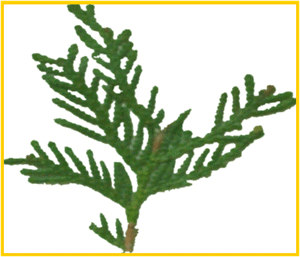 These cone-shaped trees grow up to 15-20 meters tall with a diameter of up to 30 cm. When they grow in more open areas, the bows or branches of the tree can actually extend to the ground. The scale like foliage is highly flammable and has been used by First Nations People for centuries.
These cone-shaped trees grow up to 15-20 meters tall with a diameter of up to 30 cm. When they grow in more open areas, the bows or branches of the tree can actually extend to the ground. The scale like foliage is highly flammable and has been used by First Nations People for centuries.
The bows can be used as deodorizing sweeping brooms and the wood is used for planking and ribbing in the construction of birch bark canoes. White cedar can thrive in a variety of habitats including swamps or regions with areas rocky, shallow soil. The white cedar also is home to many songbirds including the Canada Warbler and Golden-crowned Kinglet. White-tailed deer gather in cedar forests to feed. Cedar is a favorite for the common porcupine. Porcupines chew through the outer bark and feast upon the inner bark. The density with which this tree grows provides excellent cover for songbirds. Also, the shredded bark of cedar makes a good choice for campfire tinder. The foliage has a high vitamin “C” content, earning it the name “Arborvitae” or “Tree of life.”
White Pine
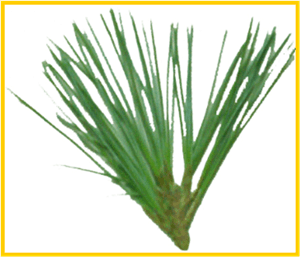 These coniferous trees can grow up to 30 or 40 metres tall. Often the white pine will have no branches for half of its tapered trunk. The foliage is in the form of long needles which are soft, flexible, and has a pleasant smell. These trees can grow in moist or moderately dry conditions. The white pine is the tallest coniferous tree in Canada. The seeds of this tree are very valuable resource for woodland creatures. Red squirrels and other mammals consume the seeds and songbirds such as Grosbeaks, Chickadees, and Siskin also use the white pine as a food source. This type of tree provides dense cover for birds and large mammals such as the moose or white-tailed deer. The bows and branches provide nesting or roosting homes for the Osprey and Eagle. The clusters of needles only grow in bundles of 5, this is a handy way of identifying the white pine. Coincidentally, the word “white” also has 5 letters.
These coniferous trees can grow up to 30 or 40 metres tall. Often the white pine will have no branches for half of its tapered trunk. The foliage is in the form of long needles which are soft, flexible, and has a pleasant smell. These trees can grow in moist or moderately dry conditions. The white pine is the tallest coniferous tree in Canada. The seeds of this tree are very valuable resource for woodland creatures. Red squirrels and other mammals consume the seeds and songbirds such as Grosbeaks, Chickadees, and Siskin also use the white pine as a food source. This type of tree provides dense cover for birds and large mammals such as the moose or white-tailed deer. The bows and branches provide nesting or roosting homes for the Osprey and Eagle. The clusters of needles only grow in bundles of 5, this is a handy way of identifying the white pine. Coincidentally, the word “white” also has 5 letters.
Attracting Birds
The Softwood Forest is an excellent area in which to attract birds. The overhead canopy is a favorite place for many species of bird to inhabit. The density of the leaves and the numerous branches and twigs provide birds with places to rest or feed, and to conceal themselves. This part of the forest is an excellent area in which to attract birds.
ACTIVITY: Pishing
The technique of Pishing is most effective in attracting many different kinds of birds and mammals near your location. The sound is just like its spelled. Make a “psssshhhh” noise anywhere along the trail and birds of all varieties may be attracted to the noise. It is important to do this continually for several minutes but it is likely that many different types of bird will become visible in the forest canopy or among the trees. Keep still and quiet other than the “psssshhhh” sound and the observe what you have attracted. Count how many different types of bird have responded to your call. Birds are curious by nature and will want to investigate this strange new noise. This technique is used by bird enthusiasts and naturalists all over the world.
Bird Trail (Marker 9)
NOTE: As of October 2016 the Bird Trail is under redevelopment; not all birds are in place.
 Are you an “all-around nature watcher?” Here is a quick test. Camp Kawartha has hidden bird pictures along the final leg of the Yellow Trail. They are life sized and are fastened to trees and branches along the trail. How many can you find? Locate more than 10 and you are a bird watching champion! Some of the birds you may find along the trail are shown on the opposite page.
Are you an “all-around nature watcher?” Here is a quick test. Camp Kawartha has hidden bird pictures along the final leg of the Yellow Trail. They are life sized and are fastened to trees and branches along the trail. How many can you find? Locate more than 10 and you are a bird watching champion! Some of the birds you may find along the trail are shown on the opposite page.
Ensuring Preservation…
The habitats and ecosystems in Ontario are very complex and sensitive. In order to preserve these systems for the animal inhabitants and also for the human observers, we must be aware of the issues and problems facing them. Canada has a vast area of land and we must strive to protect and care for the number of diverse natural worlds. Together, through education and direct experiences with nature, we can encourage people to know, care and respect the natural world around them.
We hope that this trail guide has helped you to understand and appreciate a little more about the unique ecosystems that are part of our environment here in South-Eastern Ontario. Thank you for taking the time to experience and learn with us.

